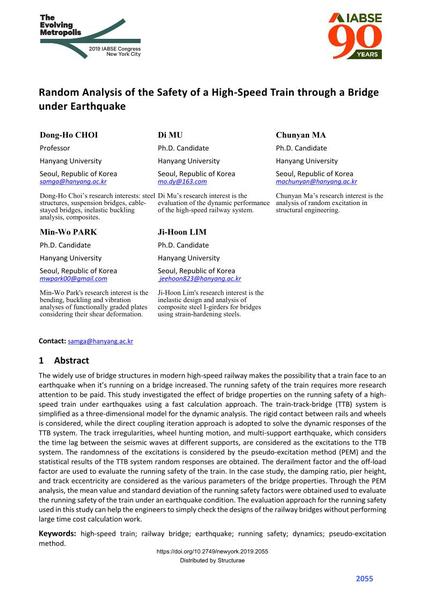Random Analysis of the Safety of a High-Speed Train through a Bridge under Earthquake

|
|
|||||||||||
Détails bibliographiques
| Auteur(s): |
Dong-Ho Choi
(Hanyang University)
Di Mu (Hanyang University) Chunyan Ma (Hanyang University) Min-Wo Park (Hanyang University) Ji-Hoon Lim (Hanyang University) |
||||
|---|---|---|---|---|---|
| Médium: | papier de conférence | ||||
| Langue(s): | anglais | ||||
| Conférence: | IABSE Congress: The Evolving Metropolis, New York, NY, USA, 4-6 September 2019 | ||||
| Publié dans: | The Evolving Metropolis | ||||
|
|||||
| Page(s): | 2055-2062 | ||||
| Nombre total de pages (du PDF): | 8 | ||||
| DOI: | 10.2749/newyork.2019.2055 | ||||
| Abstrait: |
The widely use of bridge structures in modern high-speed railway makes the possibility that a train face to an earthquake when it’s running on a bridge increased. The running safety of the train requires more research attention to be paid. This study investigated the effect of bridge properties on the running safety of a high- speed train under earthquakes using a fast calculation approach. The train-track-bridge (TTB) system is simplified as a three-dimensional model for the dynamic analysis. The rigid contact between rails and wheels is considered, while the direct coupling iteration approach is adopted to solve the dynamic responses of the TTB system. The track irregularities, wheel hunting motion, and multi-support earthquake, which considers the time lag between the seismic waves at different supports, are considered as the excitations to the TTB system. The randomness of the excitations is considered by the pseudo-excitation method (PEM) and the statistical results of the TTB system random responses are obtained. The derailment factor and the off-load factor are used to evaluate the running safety of the train. In the case study, the damping ratio, pier height, and track eccentricity are considered as the various parameters of the bridge properties. Through the PEM analysis, the mean value and standard deviation of the running safety factors were obtained used to evaluate the running safety of the train under an earthquake condition. The evaluation approach for the running safety used in this study can help the engineers to simply check the designs of the railway bridges without performing large time cost calculation work. |
||||
| Mots-clé: |
tremblement de terre pont ferroviaire
|
||||
